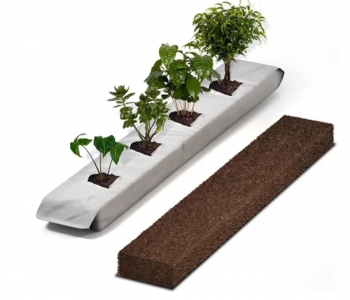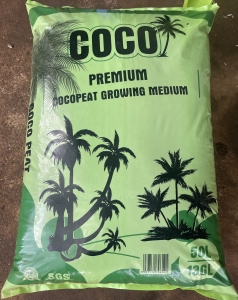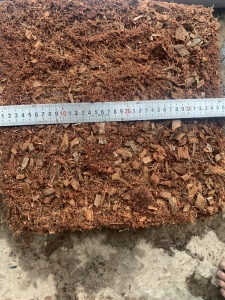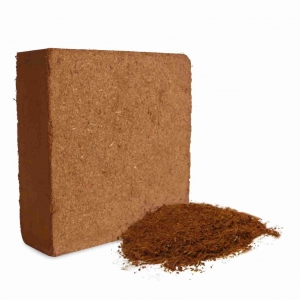What Is Coir and Where Does It Come From?
Coconut coir is growing in popularity as a seed starting and growing medium, especially, as a replacement for peat moss. But using coir for this purpose has its challenges. To shed light on the history of coir in horticulture and how its naturally high salt content can be overcome for seed starting and seedling growth, my guest this week is international agricultural consultant Dr. Hugh Allen Poole.
A resident of South Carolina and a world traveler, Dr. Poole is originally from Florida, where he earned both a bachelor’s and a master’s in ornamental horticulture from the University of Florida. In 1974, he completed his Ph.D. in agriculture at Cornell University in New York State. His studies have included tropical soils, plant pathology, plant breeding, and international agricultural development and business. His experience and expertise lie in intensive crop production systems worldwide with a focus on problem-solving and training.
I wanted to speak to Hugh after reading an article from Hort Americas on buffering coir (more on buffering later) in which he offered expert advice. I was delighted that he agreed to join me on the podcast to explain what coir is, where it comes from, and what issues growers have when they use coir.
Over the past few years, I’ve done several trials with coir to assess its viability as a seed-starting medium. I’ve tried coir products, both compressed bricks and bagged, from several different vendors, and I couldn’t believe how consistently poorly the seedlings were performing. The students in my Online Gardening Academy™ Master Seed Starting course reported similar results. In our conversation, Hugh identifies what we could do differently to get a better outcome.
Before proceeding any further with this week’s topic, I want to take a moment to let you know that I have a new book coming out this year, and it’s available for pre-order now. The title is “The Vegetable Gardening Book: Your complete guide to growing an edible organic garden from seed to harvest,” and I’m very excited for you to read it. It’s chock full of insider tips and new-to-you information that will help you step up your gardening game and tackle challenges.
What Is Coir and Where Does It Come From?
Coir is commonly pronounced “core” in the United States and “kwar” in France. In Spanish, it’s called “coco de fibra.” No matter how you pronounce it, coir is a byproduct of the coconut industry. While coconuts are primarily farmed for their white “meat,” which is used in various food products, growers have found uses for the coconut husks as well.
Hugh has visited India and Sri Lanka and seen coconut husk processing first-hand. He says it started as a cottage industry — something that families did. Once the husks were separated from the nuts, the husks were tossed into a pile or a pond so rainwater would help the fibers separate more easily.
Using knives or other tools, they break the husks into smaller parts. While rubbing the fibers of the husks, granular material — the coir — falls out.
The family that collected the coir would then send it to a factory where it was compressed into pellets or blocks. As the industry has grown, it’s become typical for whole husks to be delivered to factories, where the husks are put through a chipper. Those chips are used in hydroponic growing. In fact, Hugh says it was hydroponics in Europe that turned coir production into a true industry.
The granular coir or chipped coir, compressed into pellets or blocks, are then sent on pallets to the United States and Europe.
Coconuts are grown all over the tropics but there was historically no demand for these byproducts, and the husks went to waste. Today, coir has grown so much in popularity for horticulture that in Central America and Southeast Asia it is no longer a byproduct of farming coconuts but the product itself in many cases.
Supply chain issues have made coir more expensive in the United States. Hugh notes that shipping a container to the East Coast from Viet Nam used to cost $3,500 or $4,500 but now costs $5,000.
Coir’s Salinity Problem
When coconut husks were thrown in saltwater marshes just because there was no other place to dump them, they absorbed salt. These days, husks used in the coir industry are more likely to be soaked by rain or sprinklers than saltwater. Still, Hugh explains, coir is naturally high in salts, namely potassium and chloride.
Many nut trees and fruit trees that have husks have high levels of potassium, and coconut trees are no exception. The good thing about potassium and chlorides, according to Hugh, is that they are readily leachable. That means when the husks are flushed with freshwater, the salts will wash out.
In hydroponic growing systems that operate on a closed loop, it’s important to remove the salts. This can be accomplished through buffering, a process that uses calcium nitrate to replace the potassium with calcium and the chlorides with nitrates.
Calcium nitrate is a fertilizer but it is not organic, so buffering is not an option in organic growing. Calcium nitrate, when used in an open system, can pollute water bodies through nitrogen loading.
Coir in pots will leach salts every time you water the potted plants. Mature plants can tolerate the level of salt, and the more the plants are watered the less salt the pots will contain. However, when working with seedlings, the salt in coir is too much. Seedlings are very sensitive to soluble salts.
I have experimented with flushing coir. Starting with off-the-shelf coir products, I put coir on a window screen and sprayed it with water for several minutes in an attempt to purge the salts. I was hoping I would notice a difference, but when I compared purged coir to un-purged coir, I didn’t see any difference in my seedlings.
Hugh says washing coir is a bit more complicated than what I tried. Coir needs to be saturated with water before the salt ions are freed. “Hydrate, and then you can leach,” he says.
Testing Coir’s Salt Level
You can use an electrical conductivity meter to figure out if the salt content of coir has been reduced enough. Hugh recommends starting with a ratio of two parts water and one part hydrated coir, waiting 10-30 minutes, and then taking a reading of the water substrate. For seedlings, an EC reading of fewer than 0.5 millisiemens is the goal. For transplants, the EC could be as high as 1.5, Hugh says.
You can use distilled water for an easy, accurate reading. If you use tap water, test the EC of the tap water before mixing it with coir. Deduct the EC of the tap water from the EC reading of the substrate, and that will give you an accurate number.
Don’t Press Coir
Coir that has been over-compressed will be hydrophobic, which is the opposite of what’s needed to start seeds. Hugh says if a coir product doesn’t absorb water quickly, don’t use it for germination.
Coir is not a sponge, Hugh notes. If you press it down into a seed tray or pot, it will not spring back up the next time you apply water. Refrain from packing down coir so it retains that vital airspace.
Hugh also points out that the surface of coir dries out fast compared to peat. If starting a seed that sits on the surface of the growing medium, add vermiculite or fine sand to the top of the coir to maintain moisture contact with the seed.
I hope you enjoyed my conversation with Dr. Hugh Allen Poole and learned something new about coir. If you haven’t listened yet, you can do so now by clicking the Play button on the green bar near the top of this post.
Have you used coir successfully to start seeds or make potting mix? Let us know in the comments below.
coco coir, bulk coconut coir, coir peat blocks, bulk coco peat, coco peat, coco peat blocks, coconut husk fiber, coco poles, coconut coir bulk near me, coco peat brick, coco coir seed, coco peat pellets, coco peat organic, coco peat disc, coco huks chip, coco husk, coco, growing media, plant a tree, coconut fiber substrate, nursery media, sow seeds, grow vegetable, growing flowers, growing cannabis, growing strawberries, growing hydroponically, growing soil
















 Online: 11
Online: 11
 Total access: 4444613
Total access: 4444613